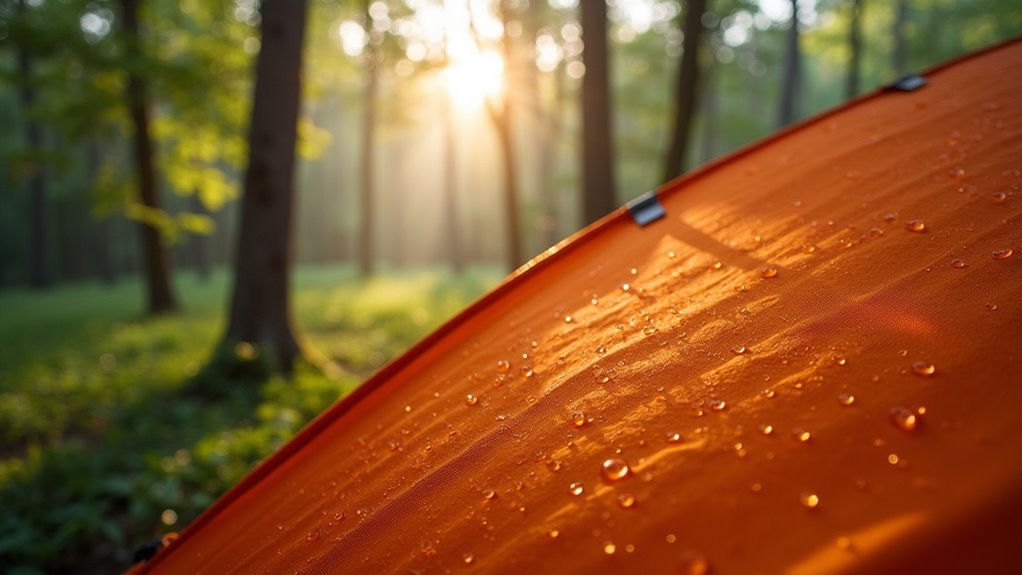What Material Are Tents Made Of
This post contains affiliate links. As an Amazon Associate, we earn from qualifying purchases.
Tents are primarily made from materials such as polyester, nylon, polycotton, canvas, and advanced composite fabrics like Dyneema. Each of these materials offers specific benefits like durability, water resistance, breathability, or lightweight strength. Further explanation and details about each fabric’s properties and uses will be provided later in the article for those interested in learning more.
Essential Facts in 30 Seconds
- Tents are made from polyester, nylon, polycotton, canvas, and composite fabrics.
- Polyester tents are durable, water-resistant, and UV resistant.
- Nylon tents are lightweight and flexible but weaken when wet and degrade under UV light.
- Polycotton tents combine cotton breathability with polyester durability, requiring some maintenance.
- Canvas tents are thick and breathable but need regular waterproofing and upkeep.
Polyester Tent Fabric
Polyester tent fabric offers strong and water-resistant qualities. It works well for camping, events, and canopies.
The dense 600D polyester weave provides excellent strength and resists wear and tear. This fabric can handle tough outdoor conditions without damage. Additionally, polyester’s weather resistance makes it a popular choice among campers.
Ripstop weaving adds extra durability by stopping tears from spreading. Polyester tents last longer under sun exposure compared to nylon tents.
Many tents get waterproof coatings that help keep rain out. Polyester is heavier than nylon but doesn’t shrink or hold moisture. It keeps its shape better during wet weather.
Campers choose polyester for its mix of strength, water resistance, and affordable price. Additionally, polyester tents are resistant to UV damage, making them ideal for sunny environments.
Nylon Tent Fabric

Nylon tent fabric is lightweight and stretchy. It works great for backpackers.
Many tents use special coatings to keep water out. This keeps you dry in rain.
You can find different strengths of nylon fabric. Pick one that matches your camping needs. It balances weight and toughness well.
Nylon tents last long and are easy to carry.
Lightweight and Elastic Properties
Nylon tent fabric weighs less than polyester, making it great for backpacking. It stretches well, with a breaking extension of 20–40%. This stretch helps the tent stay tight and strong in the wind.
Ultralight tents use lower denier nylon, like 15D or 20D, which still lasts long. Nylon absorbs some moisture, causing slight size changes. Still, it keeps its shape and protects you during your trips.
Nylon tents offer a good balance of light weight, stretch, and strength.
Coating and Waterproofing Techniques
Coating and waterproofing keep your nylon tent dry in wet weather. Use these strong methods for best results:
- Polyurethane (PU) Coatings form a thick, waterproof layer on floors and rainflies.
- Silicone Coatings make surfaces water-repellent and tough against damage.
- Durable Water Repellent (DWR) Coatings cause water to bead and roll off rainflies. Tents made from high-quality materials often perform better in wet conditions.
Clean and dry your tent before applying any coatings.
Spray waterproofing on seams for extra protection. Let the tent dry fully after spraying.
Seal seams again if leaks start to appear. This keeps your tent safe from water and extends its life. Regular maintenance ensures longevity of the tent, enhancing your overall camping experience.
Strength and Durability Variants
Nylon tent fabric offers strong and durable options for outdoor gear.
Nylon has high tensile strength and beats polyester in resisting pulling and stretching. Wet nylon loses 10-15% of its strength, so keep tents dry when possible. Regular tent maintenance can help mitigate this loss of strength.
Nylon stretches slightly, which spreads out stress and lowers tear risks at key points. This fabric resists abrasion well, making it perfect for rough landscapes and long-lasting tents.
UV light breaks down nylon faster than polyester, which can shorten its life. Ripstop nylon tents provide extra tear resistance and last longer outdoors. Additionally, waterproof finishes like silicone or polyurethane are often applied to enhance functionality.
Choose nylon for tough, reliable camping gear.
Polycotton (Polyester-Cotton Blend)

Polycotton tents mix cotton and polyester to give you the best of both.
Cotton lets air flow well, so you stay cool and comfy. Polyester adds strength and protects against sun damage.
Polycotton lasts longer than pure polyester or cotton tents. You need to keep the tent dry to stop mold from growing.
Cleaning is easier than with pure cotton tents. This blend suits campers who want comfort and durability without extra fuss.
Canvas (Cotton) Tent Fabric
Canvas tents use mostly cotton fibers. This fabric is strong and comfy. Cotton makes up 95% to 100% of the material. It feels heavy and thick. This helps the tent resist wind and rain well. Cotton also breathes well. This stops water drops from forming inside the tent on warm days.
Take care of your canvas tent to keep it lasting long. Check for holes or gaps around the seams often. Wet cotton can swell and close small holes. Always dry the tent fully before packing it away. This stops mold and mildew from growing.
Untreated tents need a waterproof spray to keep rain out. Let your tent go through wet and dry cycles before using it first time. This process helps make it more water resistant. Regularly applying waterproofing treatments ensures the tent maintains its effectiveness against moisture.
With good care, your canvas tent will stay strong and cozy for many camping trips.
Composite and Laminated Fabrics
Composite and laminated fabrics change how tents perform outdoors. These fabrics combine a strong polyester mesh with a thin polymer film. This combination makes tents tough but light.
Laminated fabrics like Dyneema Composite Fabric (DCF) have very high strength. They hold up better than normal tent materials. These fabrics also keep water out without toxic chemicals. This helps protect the environment.
Manufacturers can design fabrics based on use. For example, they make lighter fabrics for backpackers. Heavier, stronger ones suit family camping. This way, tents stay durable and easy to carry.
Other Tent Fabric Traits and Technologies
Tent fabrics with ripstop weaving resist tears better. The fabric shows a grid pattern that stops rips from spreading. This makes the tent strong and tough for rough use.
Waterproof coatings like silicone and polyurethane keep water out. Silicone lasts longer and stays flexible. Polyurethane is cheaper but can wear out faster. Both help your tent stay dry during rain.
Choose fabrics and coatings that fit your outdoor needs.
Ripstop Weaving Benefits
Ripstop weaving makes tent fabric tough and light. The special grid pattern stops small tears from growing. This keeps your tent strong in bad weather.
Ripstop fabric also holds a lot of strength but weighs very little. You can carry less weight without losing durability. It works well with many materials, perfect for camping or military use.
This fabric lasts longer and handles rough use easily. A smart choice for anyone needing strong, light gear.
Waterproof Coating Types
The right waterproof coating keeps your tent dry and strong.
PU coatings cost less and work well but break down after time.
Silicone coatings cost more but last longer and resist tears better.
PE coatings are cheap and tough but don’t breathe or block UV rays.
Fluorocarbon treatments make tents repel water and dirt faster but add to the price.
Pick a coating that fits your needs for waterproofing, strength, and weight.
Think about how you’ll use the tent to get the best protection from rain and sun. Additionally, applying waterproofing solutions to your tent can enhance its longevity and effectiveness against wet conditions.
Frequently Asked Questions
How Do I Choose the Right Tent Fabric for My Needs?
Pick tent fabric based on your trip needs. Think about weight, strength, and weather proofing. Nylon is light and strong but can wear out in sun. Polyester resists sun damage and holds shape well. Cotton feels soft and breathes but gets heavy when wet. Dyneema is very light and tough but costs more. Match fabric to your adventure for the best experience.
What Is the Lifespan of Different Tent Fabrics?
Canvas tents last about 7 to 10 years. High-performance sailcloth tents can last 10 to 15 years. Proper care and regular cleaning help tents stay strong longer. Fix tears quickly to avoid bigger damage. Good maintenance saves money and keeps your tent durable. This way, you get the most from your tent over many camping trips.
Can Tent Fabrics Be Recycled or Are They Biodegradable?
Tent fabrics do not break down naturally. They are made from synthetic materials like nylon or polyester. Recycling these fabrics is hard. Only a few places accept them for recycling. These services can be expensive and may not always work well. You can give old tents to charity or friends. Another idea: turn them into bags or covers. This saves the fabric and helps the environment. Small changes like these can make a big difference.
How Do Fabric Coatings Affect Tent Performance?
Fabric coatings make tents better. They stop water from getting inside, so you stay dry. Some coatings block sunlight too. This keeps the tent strong for many years. Protects your gear from sun damage as well. Coatings also help the tent resist dirt and stains. This means your tent stays clean and lasts longer. A good coating can double a tent’s life. It is a smart choice for any camping trip.
What Are the Environmental Impacts of Tent Fabric Production?
Tent fabric production harms the environment. It uses lots of water and energy. Factories release harmful chemicals and pollution. Organic cotton saves up to 90% water compared to regular cotton. Recycled fabrics cut waste and reduce carbon emissions. These choices help protect nature and keep the air cleaner. Sustainable fabrics also last longer, reducing the need to buy new tents often. Small changes make a big difference for our planet.
Conclusion
Tents come in different materials, each with its own benefits. Polyester and nylon tents are light and easy to carry. Canvas tents are strong and last a long time. Polycotton mixes cotton and polyester, giving both toughness and airflow. Some tents use special fabrics that block water and sunlight well. Knowing these materials helps pick the right tent for your trip. Think about weight, strength, and weather protection. This way, your camping will be safe and fun.
